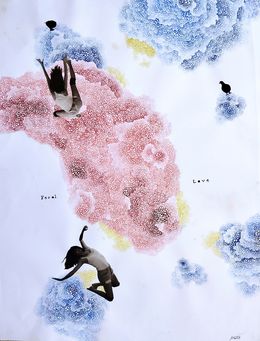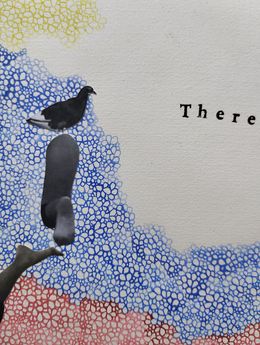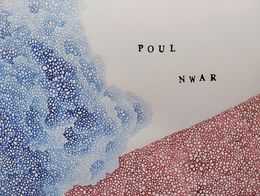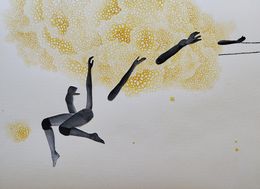From May 31 to June 25, 2025, the exhibition "Cher Ami, oiseaufantastique" will take place. C/o Fée Mazine Association, Pierrefond, Reunion Island.
Cher Ami is a bird unlike any other: rescued from the city, she has been hand-fed since birth. She has learned to interact methodically with humans in order to obtain everything she desires. Cher Ami cannot be ignored: she will jump on children's heads, court anything that moves, and dominate her humans. And we can only obey her. Fed, housed, and loved, Cher Ami will have a life expectancy of around thirty years, unlike the six years she could have lived in the city. Cher Ami lives in complete freedom with her human. Satisfied with this life, she has little interest in the neighborhood pigeon community or in mating with her own kind. The idea of composing with a city rock pigeon originated from a reflection on the text of Living with the Disorder by Donna Haraway, philosopher of science and professor in the History of Consciousness Department. Haraway gives us her point of view about the relationship between humans and pigeons, which she describes as a game of strings and engages us in her SF plots (science fiction or speculative feminism, as the case may be). The abilities of pigeons surprise and impress human beings, who often forget how other living beings or other things make them capable themselves. These others can be inside or outside bodies (human and non-human), at different scales of space and time. In any case, they shape respons(h)abilities. For this series I try to bring together all that Cher Ami embodies of fantasy, heroic, antiheroic, magical, from her silent gaze from where there is the entire agreed universe. Cher Ami is the carrier pigeon that saved the lives of 194 French soldiers during the First World War. Borrowed by pigeon fanciers in the United Kingdom for use in France, upon his return, Cher Ami was decorated with oak leaves and became the department's mascot. He was also awarded the Croix de Guerre with palm for his heroic action in delivering messages in the Verdun sector. He died at Fort Monmouth, New Jersey, on June 13, 1919, from wounds received in his last battle and was inducted into the Racing Pigeon Hall of Fame in 1931. He also received the Gold Medal from the Organized Bodies of American Racing Pigeon Fanciers in recognition of his prowess during the war. Cher Ami's stuffed body is part of the Smithsonian Institution's collection. In March 2022, the war in Ukraine was announced by the media. It was during this period that my interest in the story of Cher Ami began. Videographic objects, poetic texts, symbiotic dances, vacoa vines, nest creations, egg installations, and feather exhibitions have all made possible this fantastic transposition of Cher Ami.
We must create new kinships, lines of inventive connections. We must thus learn, in the midst of a dense present, to live well and to die together. We must sow trouble, provoke a powerful response to devastating events. We must also calm the storm and rebuild peaceful places. Donna Haraway The domestic pigeon is the city pigeon found in our cities. It is the domesticated form of the rock dove, which also survives as a wild bird in its original natural habitat: cliffs and other rocky environments. Rock doves have maintained co-domesticated relationships with humans for 10,000 years. Some Mesopotamian cuneiform tablets, 5,000 years old, attest to such relationships. It is the oldest domestic animal in the world. If the pigeon today arouses feelings of disgust, affection, or even weariness, it has had a very different past. Under the name of dove, it is represented in the Old and New Testaments, as well as in the Koran, as a benevolent animal. From being a symbol of peace, the pigeon has taken on a negative symbolism over the years, associated in the city with dirt and noise pollution (cooing, flapping wings, moving on wooden floors, droppings). For information, the dove does not correspond to any scientific classification: it is not a species and most of the time, designates a rock pigeon or a white turtledove. These kinds of creatures have a long history in the making with humans. They bind the people who take care of them to the knots formed by classes, genders, races, peoples, colonies, postcolonies. Donna Haraway Even today, in the event of war, pigeon fanciers are forced to send their birds to the army. Yet the pigeon was abandoned in the 20th century, without its consent, with the advent of new technologies and despite the progress of science, we still do not explain this unique ability of this species, to find its nest, after being released at great distances. "There is an extremely powerful force for which until now, science has not found an official explanation. It is a force that understands and governs all the others and is behind every phenomenon that operates in the universe and which has not yet been identified by our care. This universal force is Love" Albert Einstein This loyalty, which makes this species ready to give its life in order to find its nest, its offspring, its partner, has been exploited since its domestication (released at weddings, "romantic" pigeon sport, military operations, messages). Once lost, most birds die in conditions of misery. And then there are those who manage to adapt to their new life of homelessness. These people call themselves feral or ferals and ferality is a form of decolonization of nature.
The body in the creative process. Cut, dismembered, mutilated and then recomposed in a sometimes disjointed way, the body is fragmentation, exteriorization, expression of a chaos that opposes and contrasts with the drawn landscape. The desired choice is to leave to the visitor or public, the leisure to freely interpret this composition. The challenge of the creative process is movement, an internal movement that unfolds in space, a phenomenology of perception, at the service of somatic practices and corporeality and bodily ecology. The word soma also means living and present body and somatic practices are effectively based on embodied learning and the synergistic interaction between our biological functions, movement in the environment, consciousness and organic learning. This solo research, with other dancers or with the pigeon Cher Ami, was carried out at the AJCM, the youth association of Château Morange, on the occasion of the provision of the dance hall to the AJCM. Workshops around corporeality and body states, during which the creation took place, were carried out from September 2024, until the Garance passage, which caused the temporary closure of the hall. Filmed, photographed, documented in black and white, echoing the historical and heritage photography, this research actually saw, from the point of view of visual technique, a first step at the iconothèque - IHOI in 2022, as part of the "Iconographic Heritage" residency. The photo prints, cut and pasted, are made on satin paper, and the drawing is done in acrylic ink with a glass pen, on Canson paper. The choice of the Polaroid format, landscape format of 30X75 cm is made in order to prolong, slow down the visual journey. Since my first Polaroid formats in 2014 I continued to work on this outline, this 8, mathematical symbol of infinity, allowing it to transform. The staging that articulates my practice with the theater, allows me to imagine in the near future, an immersive performance, even interactive with the audiences, nourished by these boards.
Read more
























